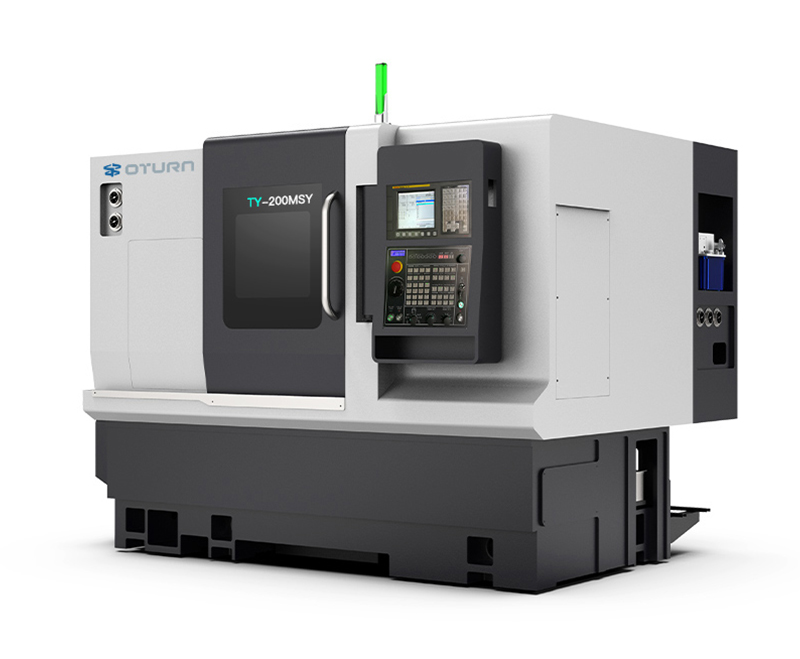High-speed CNC turning-milling composite machines are essential equipment in modern precision manufacturing. By integrating turning, milling, and other machining processes into a single platform, they significantly enhance machining accuracy and efficiency, improve operational flexibility, and effectively reduce production costs. This article explores the core advantages of these machines and their application value in the manufacturing industry, helping enterprises optimize production workflows and achieve digital transformation for sustained competitiveness.
I. Improved Machining Accuracy
· Integrated Design Minimizes Error Accumulation
High-speed turning-milling composite machines combine turning and milling functions to avoid the cumulative positioning errors caused by multiple re-clamping steps in traditional processing. Multiple complex operations can be completed in a single setup, greatly ensuring relative positional accuracy between machined surfaces. This is critical in fields with extremely high dimensional and accuracy requirements, such as aerospace engine blades and precision molds, where errors can be controlled within micron-level ranges, enhancing product quality and reliability.
· Advanced CNC Systems for Precise Control
Equipped with high-performance CNC systems, these machines precisely control tool paths, spindle speeds, and cutting parameters to achieve micron-level accuracy in both milling and turning. Flexible tool path planning and optimized cutting parameters ensure the machining of complex parts meets stringent precision and surface quality standards.
II. Increased Machining Efficiency
· Multi-Process Integration on a Single Machine
High-speed turning-milling machines support turning, milling, drilling, tapping, and other machining processes in one device, eliminating the time wasted on material handling and reclamping between multiple machines. For instance, complex shaft parts can be fully processed in one machining cycle, significantly shortening manufacturing lead times and improving overall productivity.
· High-Speed Cutting for Faster Processing
With high spindle speeds and rapid feed rates, these CNC turning center offer excellent high-speed cutting capabilities. For softer materials like aluminum alloys, machining efficiency can be increased several times compared to conventional equipment. Fast tool changes and feed movements reduce non-cutting time, accelerating production pace and meeting large-scale manufacturing demands.
III. Enhanced Machining Flexibility
· Suitable for Various Materials and Complex Parts
High-speed turning-milling composite machines can handle a wide range of metal materials, including difficult-to-machine alloys such as titanium and high-temperature alloys. They adapt to various part geometries—shafts, discs, complex housings—through programmable tool changes and paths. In the medical device industry, for example, precise manufacturing of artificial joints with intricate curved surfaces relies heavily on such machine flexibility.
· Automation Compatibility for Smart Production
Designed with automation in mind, these machines easily integrate with robotic arms, automated loading/unloading systems, and production lines, enabling unmanned manufacturing. Automated lines reduce human intervention, improve machining stability, and support continuous, high-quality mass production.
IV. Reduced Production Costs
· Lower Equipment Investment and Floor Space
By combining multiple machining functions into one versatile machine, reliance on several traditional single-purpose machines is reduced, decreasing equipment acquisition and maintenance expenses. Additionally, the smaller footprint saves valuable factory space, creating more room for production and management activities.
· Improved Material Utilization and Waste Reduction
Accurate CNC turning control minimizes deformation and scrap rates of thin-walled and complex parts, maximizing material utilization and reducing raw material waste. This indirectly lowers production costs and increases economic efficiency.
Conclusion
With its integration of multiple processes, precise control, high efficiency, and intelligent production capabilities, the high-speed CNC turning and milling composite machine has become a cornerstone equipment for modern manufacturers to enhance core competitiveness. It effectively improves the quality and consistency of complex part machining, shortens production cycles, and significantly reduces capital investment and operational costs. As smart manufacturing develops rapidly, adopting high-speed turning-milling composite machines is an essential path for enterprises striving for digital transformation and automated, efficient production.
If you aim to boost output and product quality through leading-edge machining technology, building a production system that is efficient, flexible, and cost-effective, choosing a high-speed turning-milling composite machine will deliver significant value. We look forward to partnering with you to jointly drive the manufacturing industry into a new era of intelligent innovation.
Post time: Jul-18-2025








